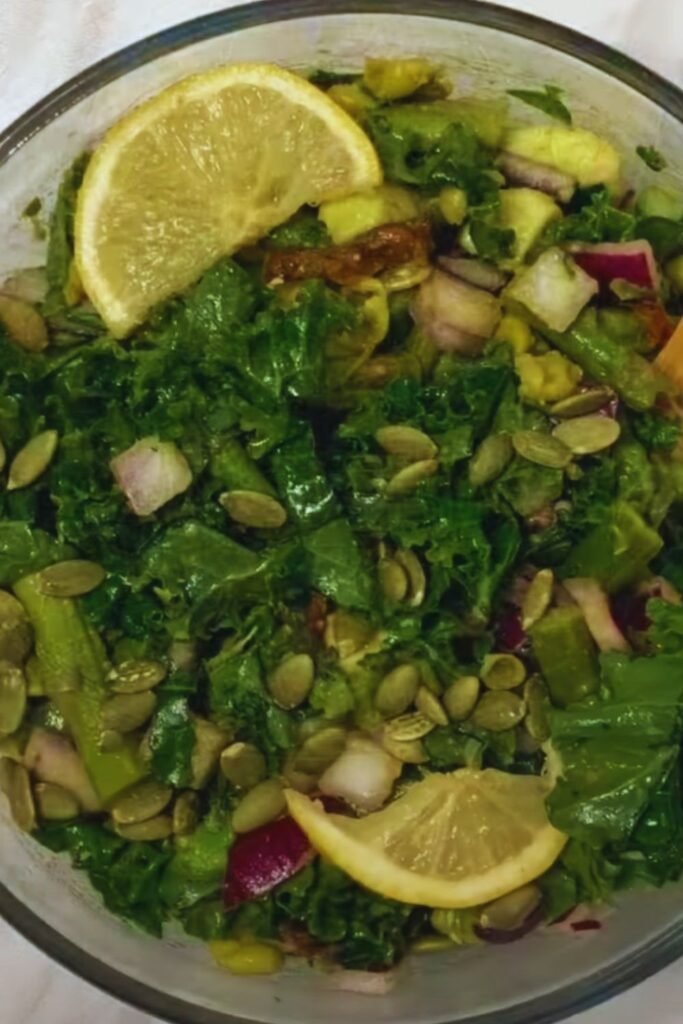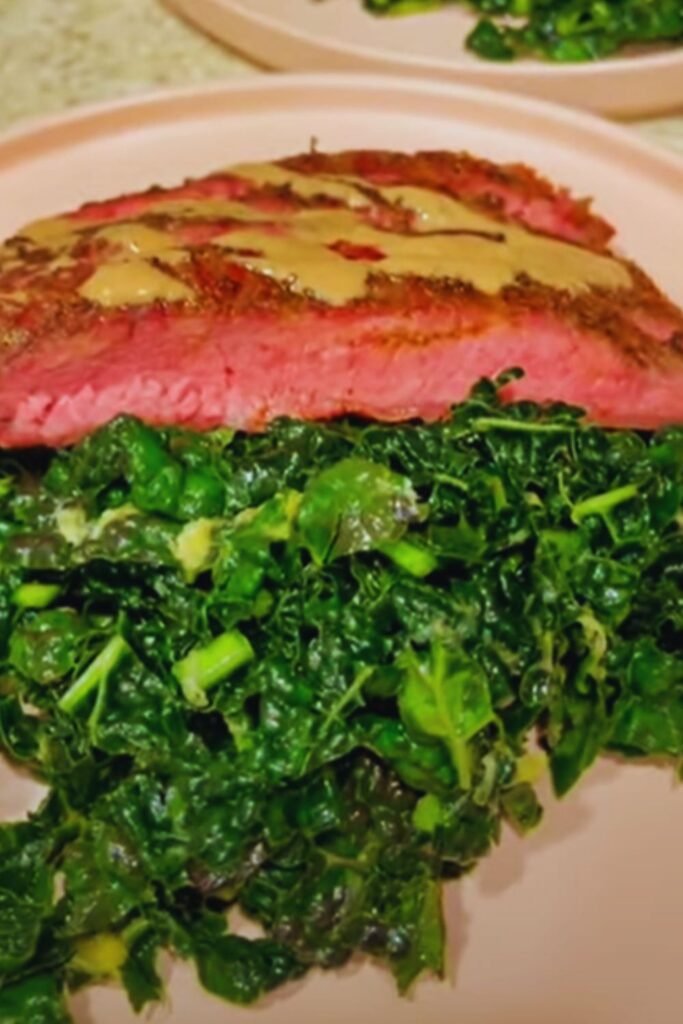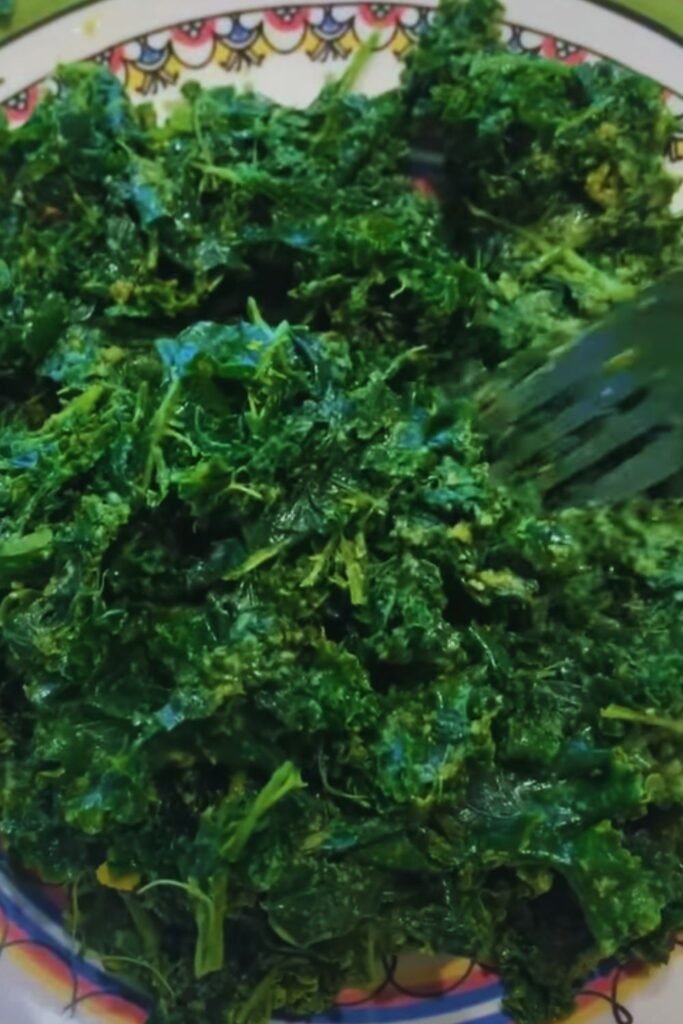As someone who spent years avoiding kale because of its tough texture, discovering the magic of kale massage changed everything for me. I remember my first encounter with a properly massaged kale salad at a friend’s dinner party – the leaves were tender, flavorful, and nothing like the chewy greens I’d struggled with before.
Today, I’m sharing my complete guide to massaging kale, transforming it from something you endure for health benefits into something you genuinely crave. This simple technique breaks down the cellulose structure in kale, making it more digestible and infinitely more enjoyable.
Why Massage Kale?
Kale in its raw form can be tough, bitter, and difficult to digest. When you massage kale, you’re essentially breaking down the cell walls of the leaves, which:
- Softens the texture significantly
- Reduces bitterness and improves flavor
- Makes nutrients more bioavailable
- Creates a better eating experience
- Helps your body digest the greens more easily
Think of it as giving your salad a head start on digestion before it even reaches your mouth. I’ve converted countless kale skeptics with this technique alone.
Choosing the Right Kale Varieties
Not all kale is created equal when it comes to massaging. Here’s my breakdown of common varieties:
| Variety | Appearance | Flavor Profile | Best Uses After Massage | Massage Difficulty |
|---|---|---|---|---|
| Curly Kale | Ruffled, bright green leaves | Mild peppery, slightly bitter | Salads, slaws, general purpose | Medium – Takes 3-5 minutes |
| Lacinato (Dinosaur/Tuscan) | Dark, bumpy elongated leaves | Earthy, slightly sweeter | Salads, Italian dishes | Easy – Takes 2-3 minutes |
| Red Russian | Purple stems, flat green-purple leaves | Tender, mild flavor | Fresh salads, delicate dishes | Very Easy – Takes 1-2 minutes |
| Baby Kale | Small, tender leaves | Milder than mature kale | Quick salads, minimal massage needed | Very Easy – 30-60 seconds |
| Redbor Kale | Deep purple ruffled leaves | Similar to curly but milder | Statement salads, beautiful presentation | Medium – Takes 3-5 minutes |
I usually reach for lacinato (dinosaur) kale for my massaged salads. Its sturdy texture holds up well to massaging without turning mushy, and its earthy flavor mellows beautifully.
Essential Tools for Perfect Kale Massage
You don’t need fancy equipment, but a few basic items make the process easier:
- Large mixing bowl (wider is better than deeper)
- Clean hands (your most important tools)
- Sharp knife for removing stems
- Cutting board
- Salad spinner (optional but helpful)
- Measuring spoons for dressing ingredients
I invested in a large stainless steel mixing bowl specifically for kale preparation, and it’s been worth every penny for the extra workspace it provides.
Step-by-Step Kale Massage Technique
Here’s my foolproof method for perfectly massaged kale:
1. Preparation Phase
First things first, we need to get the kale ready for its massage:
- Wash your kale thoroughly under cold running water
- Pat dry with clean kitchen towels or use a salad spinner
- Remove the tough center stems by holding the stem with one hand and stripping the leaves away with the other
- Tear or chop the leaves into bite-sized pieces
- Place the prepared leaves in your large bowl

2. Basic Massage Technique
Now for the actual massage:
- Add a small amount of olive oil (about 1 tablespoon per bunch of kale)
- Add a pinch of salt (kosher or sea salt works best)
- With clean hands, grab handfuls of kale and gently squeeze, roll, and press the leaves
- Continue this motion, reaching to the bottom of the bowl and bringing leaves to the top
- Massage for 3-5 minutes until the kale turns a deeper green and noticeably softens
The transformation is remarkable – you’ll actually see the leaves shrink in volume by about 30% as they become more tender.
3. Testing Doneness
How do you know when your kale is properly massaged? I use these indicators:
- Color change: The leaves turn a deeper, more vibrant green
- Volume reduction: The pile of kale significantly decreases in size
- Texture test: Take a piece and bend it – it should fold easily without breaking
- Taste test: The flavor should be milder, less bitter, and more pleasant
I find the texture test most reliable – when the leaves feel silky rather than rough, you’re there.
The Science Behind Kale Massage
I’m fascinated by the science of cooking, so let me explain what’s happening when you massage kale:
Kale contains cellulose and other complex carbohydrates in its cell walls that make the leaves rigid and tough. The physical action of massaging, combined with the acid from lemon juice or vinegar in your dressing, breaks down these structures. The salt helps draw out moisture through osmosis, while oils penetrate the leaves’ waxy surface.
This process is similar to marination, but accelerated through physical manipulation. The result is partially broken-down cell walls that would normally require more extensive chewing and digestion.
Beyond Basic: Advanced Kale Massage Techniques
Once you’ve mastered the basics, try these advanced approaches:
Acid Massage Method
This is my go-to for particularly tough kale:
- Add 1 tablespoon fresh lemon juice or vinegar to your massage mix
- The acid helps break down the leaves more effectively
- Massage time: 2-3 minutes
Hot Water Flash Method
For extremely tender results:
- Blanch kale in boiling water for just 10 seconds
- Immediately plunge into ice water to stop cooking
- Dry thoroughly, then proceed with a brief 1-minute massage
- Perfect for those who want maximum tenderness
Avocado Massage
My personal favorite for creamy kale salads:
- Add half a ripe avocado to your kale
- Massage the avocado directly into the leaves
- The oils and fats in the avocado tenderize while creating a creamy dressing base
- Massage time: 3 minutes

Troubleshooting Kale Massage Problems
Even experienced kale massagers run into issues. Here are solutions to common problems:
| Problem | Possible Causes | Solution |
|---|---|---|
| Kale still too tough after massage | Insufficient massage time, mature kale, not enough oil | Increase massage time by 2-3 minutes, add a splash more acid, consider blanching briefly |
| Kale turning mushy | Over-massaged, too much acid, wrong variety | Use a firmer variety like lacinato, reduce massage time, use less acid |
| Bitter taste persists | Old kale, insufficient massage | Add a touch of honey or maple syrup to dressing, increase massage time |
| Kale too salty | Too much salt in massage | Rinse quickly under cold water, spin dry, add unsalted ingredients |
| Massage taking too long | Tough variety, large pieces | Cut into smaller pieces, use younger kale, try the acid method |
The most common mistake I see is not massaging long enough. Don’t rush this process – those few extra minutes make all the difference.
My Favorite Massaged Kale Salad Recipes
Here are three of my most requested massaged kale salad recipes:
1. Mediterranean Massaged Kale
Ingredients:
- 1 bunch lacinato kale, massaged
- 1/4 cup olive oil
- 2 tbsp lemon juice
- 1/2 cup cherry tomatoes, halved
- 1/3 cup kalamata olives, pitted and sliced
- 1/4 cup red onion, thinly sliced
- 1/3 cup cucumber, diced
- 1/2 cup chickpeas, rinsed and drained
- 2 oz feta cheese, crumbled
- 1 tbsp fresh oregano, chopped
- Salt and pepper to taste
Directions:
- Massage kale with 1 tbsp olive oil and a pinch of salt for 3-4 minutes
- Whisk remaining oil with lemon juice to create dressing
- Toss all ingredients with the massaged kale
- Let sit for 15 minutes before serving
2. Autumn Harvest Kale Salad
Ingredients:
- 1 bunch curly kale, massaged
- 2 tbsp apple cider vinegar
- 3 tbsp olive oil
- 1 apple, thinly sliced
- 1/3 cup dried cranberries
- 1/3 cup walnuts, toasted and chopped
- 1/4 cup red onion, finely diced
- 2 oz goat cheese, crumbled
- 1 tbsp maple syrup
- Salt and pepper to taste
Directions:
- Massage kale with 1 tbsp olive oil and a pinch of salt for 3-4 minutes
- Whisk remaining oil with apple cider vinegar and maple syrup
- Toss all ingredients together
- Let rest for 10 minutes before serving
3. Asian-Inspired Sesame Kale
Ingredients:
- 1 bunch lacinato kale, massaged
- 2 tbsp sesame oil
- 1 tbsp rice vinegar
- 1 tbsp soy sauce
- 1 tsp honey
- 1 carrot, julienned
- 1 red bell pepper, thinly sliced
- 1/4 cup edamame, shelled
- 2 tbsp sesame seeds, toasted
- 1 green onion, sliced
Directions:
- Massage kale with 1 tbsp sesame oil for 3 minutes
- Mix remaining sesame oil with rice vinegar, soy sauce, and honey
- Toss with all vegetables and sesame seeds
- Garnish with green onion

Serving and Storage Tips
Massaged kale has different serving and storage considerations than regular salad greens:
- Immediate serving: Massaged kale is ready to eat right away, but tastes even better after 15-30 minutes of resting
- Make ahead: Unlike other dressed salads, massaged kale can be prepared up to 24 hours in advance
- Storage: Keep in an airtight container in the refrigerator for up to 3 days
- Reviving: If stored kale becomes slightly wilted, add a splash of fresh lemon juice and toss again
- Temperature: Massaged kale salads taste better at room temperature than cold
I often prepare my massaged kale the morning before a dinner party, which allows the flavors to develop throughout the day.
Nutritional Benefits of Massaged Kale
While massaging makes kale more enjoyable, it preserves (and even enhances) its impressive nutritional profile:
| Nutrient | Amount per Cup (Raw) | How Massaging Affects It |
|---|---|---|
| Vitamin K | 684% Daily Value | Maintained, slightly more bioavailable |
| Vitamin A | 206% Daily Value | Maintained |
| Vitamin C | 134% Daily Value | Slight decrease but still high |
| Manganese | 26% Daily Value | Maintained |
| Copper | 10% Daily Value | Maintained |
| Fiber | 2g | Unchanged but easier to digest |
| Protein | 2.9g | Unchanged |
| Calories | Approximately 33 | Unchanged (not counting dressing) |
The massage process makes these nutrients more accessible to your body while preserving their content. My digestion is noticeably better when I eat properly massaged kale compared to raw.
Creative Uses Beyond Salads
Massaged kale isn’t just for salads! Here are some unexpected ways I use it:
- As a sandwich base instead of lettuce
- Folded into scrambled eggs or omelets
- As a base for grain bowls
- Mixed into pasta during the last minute of cooking
- Layered in lasagna
- Added to smoothies (pre-massaging reduces the volume and bitterness)
- As a pizza topping (add after baking)
- Wrapped around fillings as a healthier alternative to tortillas
My family’s favorite is using massaged kale as a base for taco fillings instead of shredded lettuce – the sturdier texture holds up beautifully to hot ingredients.
Frequently Asked Questions About Massaging Kale
Here are answers to questions I commonly receive:
Q: Can I use a food processor instead of hand-massaging?
No, I don’t recommend it. Food processors cut rather than massage, which won’t break down the cell walls in the same beneficial way. The cutting action can actually increase bitterness.
Q: How long does massaged kale keep in the refrigerator?
Undressed massaged kale will keep for 2-3 days. Dressed massaged kale salads can last 1-2 days, though textures of other ingredients may change.
Q: Can I massage frozen kale?
I don’t recommend it. Freezing already breaks down cell walls, creating a mushy texture when thawed. Fresh kale produces much better results.
Q: Is massaged kale more nutritious than raw kale?
The nutritional content remains similar, but your body can access and absorb the nutrients more effectively from massaged kale due to the broken-down cell structure.
Q: Can children help with massaging kale?
Absolutely! It’s a great way to get kids involved in the kitchen. Just ensure their hands are clean and supervise younger children.
Q: Why does my kale taste better the next day?
The flavors continue to develop over time, similar to how soups and stews taste better the next day. The acids and oils continue to work on the kale structure.
Final Thoughts: Embracing the Ritual
I’ve come to see massaging kale as more than just a food preparation technique – it’s become a mindful ritual in my cooking practice. There’s something deeply satisfying about transforming this tough, sometimes intimidating vegetable into something delicious through the work of your own hands.
When I take the time to properly massage my kale, I’m more invested in the meal and appreciate the flavors more fully. It’s a simple act of care that elevates a basic ingredient into something special.
Whether you’re a kale enthusiast or a skeptic, I encourage you to try this technique. You might just find, as I did, that the humble act of massaging your greens becomes one of your favorite kitchen rituals – and the gateway to actually enjoying one of the world’s most nutritious vegetables.


